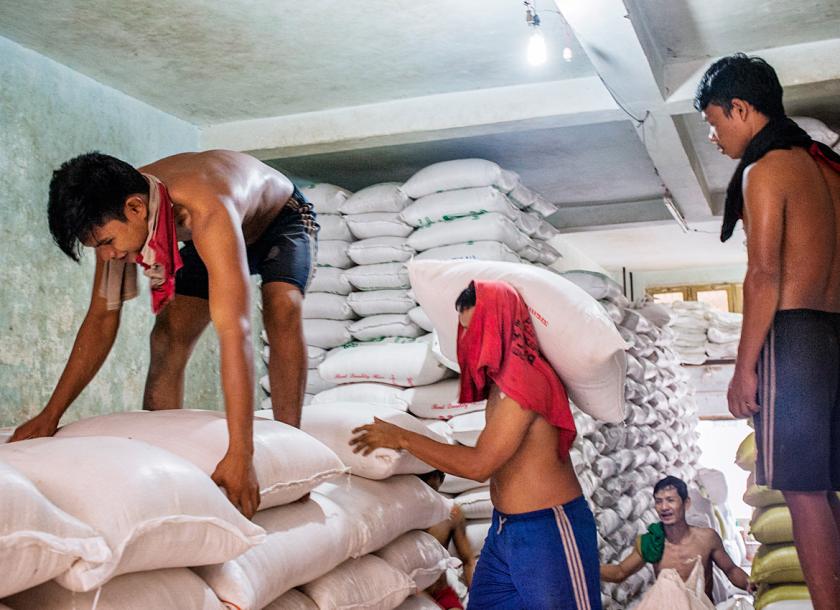Myanmar: Rice exports surge despite fraud; but government can still play a bigger role
Despite higher incidences of trading fraud, rice exports are expected to increase in 2018 on the back of demand from China, the largest importer of Myanmar rice, as well as other countries like Bangladesh and Sri Lanka, rice traders said.
Last year, fraudulent traders made off with some K10 billion in rice revenues, according to the Ministry of Commerce (MOC) and Myanmar Rice Federation (MRF). The most recent incident of fraud involves A.S.O Company, which charged merchants in advance for rice supplies worth K5.6 billion, the Bayintnaung Commodity Depot said. The supplies were never delivered.
A.S.O Co had been involved in the rice trade for two years, but it had not registered as a member with the MRF, Myanmar Rice Merchants Association and Bayintnaung Commodity Depot, The Myanmar Times understands.
U Aung Swe Oo, who owns A.S.O Co, is allegedly missing but still within the country after being accused of swindling the money, the Bayintnaung Commodity Depot announced on January 6 and 19. His family members fled Myanmar between January 2 and 5, data from the immigration department shows. A total of 64 complaints, including one by a foreign company, have been filed.
In a separate incident, 50 rice traders from Mandalay and Sagaing reported missed export payments from China worth K5 billion after their Chinese partner was allegedly arrested and unable to receive the supplies.
Rising exports
The number of fraudulent incidents is taking place at a time when rice exports are at their highest level in 60 years. Since the start of the 2017-18 fiscal year on April 1, 2017 up until January 5, Myanmar exported more than 2.6 million tonnes of rice. By the end of the fiscal year on March 31, the MOC expects total exports to reach 3 million tonnes, backed by China and new demand from Bangladesh, which has committed to importing a million tonnes of Myanmar rice this year.
Local consumption has also been on the rise, with the rice prices up by K10,000 per 50 kilograms compared to K2,000 in the export market. Myanmar currently produces 13 million tonnes of rice, around 60 percent of which is consumed locally.
Meanwhile, more farmers are entering the rice production business. “Since the pulse and bean sector collapsed, more farmers have switched to producing rice as they see strong demand for this crop,” said U Sai Kyaw.
As such, the government should take steps to prevent fraud and draw up clear policies for efficient and transparent trading of rice. “Rice is the most important crop for exports so the government should play a greater role in supporting an effective and efficient market for the trade,” said U Tin Hlaing Win, chairman for the Paddy Producing and Distribution Association in Mandalay.
For example, the government can provide warehouses for local storage and improve trade financing support for local traders who are currently at the mercy of Chinese traders. Due to the lack of storage facilities and trade financing, traders are forced to store rice supplies in China and accept credit based on Chinese terms.
U Sai Kyaw, an official of the MRF, added that a clear export policy should be drawn up with procedures on how rice should be traded with international buyers. “We need an export policy which provides access to information on traders such as their background as well as prices for each season. This will help prevent fraud,” he said.
Government support
For its part, the government on Tuesday set a target loan amount totaling K65 billion for small and medium-sized enterprises (SMEs) in the rice sector. The MRF, with the applied SME loans, plans to allocate the financial resources into eight sectors, including seed production, export business, joint-venture formation, upgrading machineries, setting up rice mills and power supply, among others.
In addition, the MRF is drafting a working programme for the rice sector, in terms of finances, management and other issues which SMEs are facing. Implementation is expected to begin in April.
The construction of rice and paddy warehouses and related machineries will be set as priorities, thus those projects will be given special consideration for loans. The MRF expects that 20 percent of all the loans will be dedicated to warehouses, whereas 18pc will go to construction of energy plants and 17pc will have reserved for upgrading rice machineries on the field.
Meanwhile, the MOC, Ministry of Agriculture, Livestock and Irrigation and the MRF will meet to restructure the rice market, U Toe Aung Myint, permanent secretary of the MOC told The Myanmar Times Tuesday.
Source: https://www.mmtimes.com/news/rice-exports-surge-despite-fraud-government-can-still-play-bigger-role.html


 English
English




